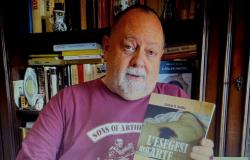In a picturesque village in the north of England, the new vicar Rebecca Holland is still trying to settle into the community but thinks she has made some progress, winning the affection of some faithful – although their number is certainly not exorbitant – who attend the small local church. The same cannot be said for her little daughter Grace, who it has not yet managed to integrate fully among his peers and manifests profound intolerance.
A legend hovers in the community relating to a mysterious figure of folklore, the so-called Lord of Disorder, who from time immemorial would watch over the members of the village in his own way. During a masquerade celebration of pagan descent, Grace mysteriously disappears into the nearby forest together with an individual with a covered face and the police searches are stumbling in the dark. Rebecca and her husband Henry, consumed by desperation, will try to find out first hand what really happened…
The Lord of Disorder & Co.

The folk horror must start from narratively solid assumptions to be credible: just think of two exponents, different and complementary to each other and both cult like The Wicker Man (1973) and The VVitch (2015), which built the atmosphere on a solid premise. The same cannot be said for The Lord of Disorder – the literal tradition from the English of the title is unintentionally out of place – which suffers from a rarely plausible script in the hundred minutes in which the increasingly tormented events unfold. Paradoxically the story recalls in several passages the memorable film which featured an iconic Christopher Lee, but here mysticism is lost in a watered-down script which forcibly brings into play the Christian religion itself as the last anchor of salvation, against a pagan cult and real or presumed monsters.
A Classic Horror Story, review: between slasher and folk horror, the Netflix film tells of a scary Italy
A feeling never born

The impact of this quiet family with a previously foreign community is not properly explored through the necessary interactions with the secondary characters or with the one who will ultimately embody the actual villain, while the background of the new vicar itself is limited to the indispensable minimum, preventing the audience from fully communing with her and her understandable torment, not to mention that anonymous, single-purpose husband in the climaxes. She breathes like this an air of improvisation in the management of the story, with the most suggestive sequences entrusted to the final “showdown”, where real and supernatural mix in a fascinating and restless hybrid that is supported by captivating design choices. The atmosphere itself is at times successfulespecially in outdoor sequences and in those forests that hide multiple dangers, and elsewhere impalpablelike when the protagonist finds herself facing the true face of the town she now considered her home.
Setting and characters of The Lord of Disorder

The perpetually gloomy sky is not the only environmental element key to the narrative, which it also boasts a lunar eclipse to infuse that pinch of apocalyptic flavor to the story, with the pagan soul trying to get under the skin but not finding the right response to a direction without flasheswhich limits itself to exposing without ever finding the right personality to make what is actually shown interesting. If Ralph Ineson then he is quite disturbing in the guise of a cryptic key figure of this small village – literally forgotten by God – he is not as effective Tuppence Middleton in the unlikely guise of this woman of the Church forced to make a deal with the devilor whoever, to try to bring his beloved little girl back to safety, with all the consequences of the case.
Conclusions
The new vicar of a small village in northern England watches in horror as her little daughter is kidnapped, after she disappears in the local forest during a pagan celebration. In trying to find her, she will discover a terrifying truth about the local community and her faith in God may not be enough… A folk horror that wastes the considerable potential given by the fascinating premise, reminiscent of great classics but unable to deal with uncomfortable comparisons. This is due to a script that is far too compressed and unresolved, which leaves more questions than answers, and a direction that only works in a handful of fairly disturbing sequences, lacking tension in the remaining minutes.
Because we like it
- A couple of passages reach the right climax.
- Ralph Ineson has the right face for the role reserved for him.
What’s wrong
- The tension is absent for a good part of the film.
- The screenplay borrows here and there from much more inspired models and does not fully convince.









